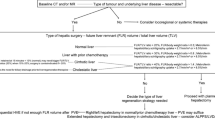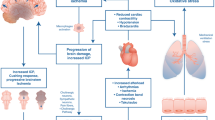Abstract
Background
Selection of appropriate donors after rigorous evaluation is of paramount importance in living-donor liver transplantation. Despite this, donor surgery may not proceed due to unforeseen reasons. The aim of this paper is to study reasons for “no go” donor hepatectomy in living liver donors.
Patients and methods
Donor operations stopped after surgical start, directly due to donor safety-related reasons, qualified for inclusion as “no go” donor hepatectomy. Living-donor evaluation was performed as per standard protocol. Data for consecutive living liver donors operated between April 2012 and November 2016 were analyzed to evaluate reasons for “no go” donor hepatectomy in a liver transplantation unit at a tertiary care teaching hospital.
Results
In 307 donors, the operation was aborted in 7 (2.3 %). One patient had unexpected biliary pathology with fibrosis found intraoperatively. Operations in five donors were abandoned in view of liver parenchymal abnormalities (fibrosis/steatohepatitis). One donor had hemodynamically significant bradycardia after handling the round ligament. All these donors recovered uneventfully and remained well on follow-up.
Conclusions
“No go” donor hepatectomy remains a real possibility despite rigorous assessment. Although thresholds for on-table rejection of the donor after complete evaluation vary, “no go” hepatectomy is a calculated risk-avoidance approach.



Similar content being viewed by others
Abbreviations
- LDLT:
-
Living-donor liver transplantation
- LLD:
-
Live liver donor
- BMI:
-
Body mass index
- LFT:
-
Liver function tests
- CT:
-
Computed tomography
- LAI:
-
Liver attenuation index
- MRCP:
-
Magnetic resonance cholangiopancreatography
- MHV:
-
Middle hepatic vein
- HE:
-
Hematoxylin–eosin
- MT:
-
Masson’s trichrome
- DDLT:
-
Deceased-donor liver transplantation
References
Pamecha V, Mahansaria SS, Bharathy KG, Kumar S, Sasturkar SV, Sinha PK, et al. Selection and outcome of the potential live liver donor. Hepatol Int. 2016;10:657–64.
Shiffman ML, Brown RS, OlthoffKM Everson G, Miller C, Siegler M, et al. Living donor liver transplantation: summary of a conference at The National Institutes of Health. Liver Transpl. 2002;8:174–88.
Guba M, Adcock L, MacLeod C, Cattral M, Greig P, Levy G, et al. Intraoperative “no go” donor hepatectomies in living donor liver transplantation. Am J Transplant. 2010;10:612–8.
Lei JY, Yan LN. Intraoperative “no go” donor hepatectomy in living donor liver transplantation. Transplant Proc. 2013;45:2253–7.
Basaran C, Agildere AM, Donmez FY, Sevmis S, Budakoglu I, Karakayali H, et al. MR cholangiopancreatography with T2-weighted prospective acquisition correction turbo spin-echo sequence of the biliary anatomy of potential living liver transplant donors. AJR Am J Roentgenol. 2008;190:1527–33.
Song GW, Lee SG, Hwang S, Sung GB, Park KM, Kim KH, et al. Preoperative evaluation of biliary anatomy of donor in living donor liver transplantation by conventional non enhanced magnetic resonance cholangiography. Transpl Int. 2007;20:167–73.
Ragab A, Lopez-Soler RI, Oto A, Testa G. Correlation between 3D-MRCP and intra-operative findings in right liver donors. Hepatobiliary Surg Nutr. 2013;2:7–13.
Pamecha V, Bharathy KG, Kumar S, Sasturkar SV, Sinha PK. Biliary complications after living donor hepatectomy: a first report from India. Liver Transpl. 2016;22:607–14.
Simpson MA, Verbesey JE, Khettry U, Morin DS, Gordon FD, Burns DL, et al. Successful algorithm for selective liver biopsy in the right hepatic lobe live donor (RHLD). Am J Transplant. 2008;8:832–8.
Herrero JI, Rotellar F, Benito A, Sola I, D’Avola D, Marti P, et al. Is liver biopsy necessary in the evaluation of a living donor for liver transplantation? Transplant Proc. 2014;46:3082–3.
Jun MJ, Shim JH, Kim SY, Seo N, Kim KM, Lim YS, et al. Clinical implications of preoperative and intraoperative liver biopsies for evaluating donor steatosis in living related liver transplantation. Liver Transpl. 2014;20:437–45.
Hegab B, Abdelfattah MR, Azzam A, Mohamed H, Al Hamoudi W, Alkhail FA, et al. Day-of-surgery rejection of donors in living donor liver transplantation. World J Hepatol. 2012;4:299–304.
Hwang S, Lee SG, Lee YJ, Sung KB, Park KM, Kim KH, et al. Lesson learned from 1,000 living donor liver transplantations in a single center: how to make living donations safe. Liver Transpl. 2006;12:920–7.
Vij V, Ramaswamy VK, Goja S, Dargan P, Mallya A, Goyal N, et al. Intraoperative “no go” donor hepatectomy in living donor liver transplantation. Am J Transplant. 2010;10:2181–2.
Ghobrial RM, Freise CE, Trotter JF, Tong L, Ojo AO, Fair JH, et al. A2ALL Study Group. Donor morbidity after living donation for liver transplantation. Gastroenterology. 2008;135:468–76.
Bharathy KGS, Kumar S, Pandey V, Sinha PK, Sasturkar SV, Pamecha V. Re-expansion pulmonary oedema: an unusual and unsettling complication. ANZ J Surg. 2017;87:638–9.
Funding
Authors did not receive any funding/grants for this work.
Author contributions
Study conception: Viniyendra Pamecha; manuscript drafting: Shyam Sunder Mahansaria, Kishore GS Bharathy; data collection: Piyush Kumar Sinha, Shridhar Vasantrao Sasturkar; critical revision of the manuscript for important intellectual content: Viniyendra Pamecha, Archana Rastogi, Kishore GS Bharathy.
Author information
Authors and Affiliations
Corresponding author
Ethics declarations
Conflict of interest
Viniyendra Pamecha, Kishore G. S. Bharathy, Shyam S. Mahansaria, Piyush K. Sinha, Archana Rastogi and Shridhar V. Sasturkar have no conflicts of interest to disclose.
Ethical standard
All authors declare no potential conflicts of interest, financial or otherwise. The study is in accordance with the 1964 Helsinki Declaration and approved by the Institute’s review board and ethics committee. Standard protocol was followed in clinical management, and informed consent was obtained from all individual participants included in the study.
Rights and permissions
About this article
Cite this article
Pamecha, V., Bharathy, K.G.S., Mahansaria, S.S. et al. “No go” donor hepatectomy in living-donor liver transplantation. Hepatol Int 12, 67–74 (2018). https://doi.org/10.1007/s12072-017-9832-z
Received:
Accepted:
Published:
Issue Date:
DOI: https://doi.org/10.1007/s12072-017-9832-z




